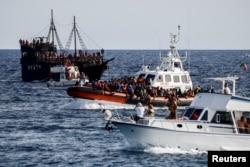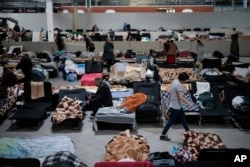The number of people seeking asylum in European countries this year is projected to surpass 1 million, reaching levels not seen since 2016 when 1.16 million asylum-seekers were reported.
Syrians and Afghans continue to be the two largest groups of asylum-seekers, as they have been for several years, submitting 100,000 and 86,000 applications respectively from January to September 2023, according to the European Union Agency for Asylum (EUAA).
A remarkable uptick in the number of migrants from several African countries, mostly from Tunisia, Libya and Algeria, has also been reported this year.
A total of 213,896 migrants from Africa reached Europe through three Mediterranean routes from January to September, 60% more than the same period in 2022 and 105% higher than the year before, the International Organization for Migration has reported.
"Unfortunately, the numbers are likely to increase further because all the factors driving displacement are increasing — war, armed violence and instability, and authoritarianism with its related persecution and repression," said Catherine Woollard, director of the European Council on Refugees and Exiles, an alliance of more than 110 nongovernmental organizations in Europe.
In addition to migrants from Africa and Asia, more than 4 million Ukrainians have sought temporary protection in European countries since the Russian invasion of their country in February 2022.
"It should be noted that although there is an upward trend, these are still manageable numbers for Europe. The response to massive displacement from Ukraine in 2022 shows that Europe can manage the arrival of refugees when the decisions are taken to manage," Woollard told VOA in emailed comments.
Deadly routes
More than 2,500 migrants lost their lives or went missing trying to reach Europe through sea routes in the first eight months of this year, according to the U.N. Refugee Agency (UNHCR).
"Lives are also lost on land away from public attention," Ruven Menikdiwela, a UNHCR official, told the U.N. Security Council in September.
"Refugees and migrants traveling along the land routes from sub-Saharan Africa risk death and gross human rights violations at every step."
Even after reaching their European destination, some migrants end up facing an uncertain future because their asylum petitions are denied.
While the overall acceptance rate for Syrian asylum applicants has remained high at over 90%, four in 10 Afghans are turned down.
The United Nations has reported significant reductions in conflict-related civilian casualties in Afghanistan since the Taliban reclaimed power over two years ago, but many Afghans still flee their country due to fears over personal security, poverty and the Taliban's repressive policies.
Migrants from Turkey, the third-largest group, have a below 50% recognition acceptance rate, according to EUAA statistics.
"For many years now, we have highlighted the 'asylum lottery' facing asylum-seekers in Europe," Woollard said, adding that countries have pursued dissimilar policies, sometimes influenced by political circumstances, in response to asylum petitions.
Inflation and other pressing social and economic challenges, including the right to work, freedom of movement and reunion with immediate family members, have also influenced migration policies of European countries.
Last month, 27 members of the European Union agreed on a set of reforms in the bloc's migration system. The European Parliament is expected to approve the reforms before its 2024 elections.










